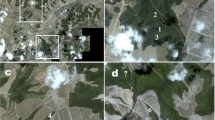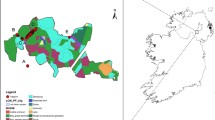Abstract
Population genetic structure and genetic diversity levels are important issues to understand population dynamics and to guide forest management plans. The Brazil nut tree (Bertholletia excelsa Bonpl.) is an endemic species, widely distributed through Amazonian upland forests and also an important species for the local extractive economy. Our aim was to analyze the genetic structure of Brazil nut trees at both fine and large scales throughout the Amazon Basin, contributing to the knowledge base on this species and to generate information to support plans for its conservation. We genotyped individuals from nine sites distributed in five regions of the Brazilian Amazon using 11 microsatellite loci. We found an excess of heterozygotes in most populations, with significant negative inbreeding coefficients (f) for five of them and the fine-scale structure, when present, was very small. These results, as a consequence of self-incompatibility, indicate that conservation plans for B. excelsa must include the maintenance of genetic diversity within populations to ensure viable amounts of seeds for both economic purposes and for the local persistence of the species.




Similar content being viewed by others
References
Avise JC, Hamrick JL (1996) Conservation genetics: case histories from nature. Chapman & Hall, New York
Azevedo VCR, Kanashiro M, Ciampi AY, Grattapaglia D (2007) Genetic structure and mating system of Manilkara huberi (Ducke) A. Chev., a heavily logged Amazonian timber species. J Hered 98(7):646–654
Balloux F (2004) Heterozygote excess in small populations and the heterozygote-excess effective population size. Evolution 58(9):1891–1900
Bittencourt JVM, Sebbenn AM (2009) Genetic effects of forest fragmentation in high-density Araucaria angustifolia populations in southern Brazil. Tree Genet Genomes 5(4):573–582
Bizoux JP, Daïnou K, Bourland N, Hardy OJ, Heuertz M, Mahy G, Doucet JL (2009) Spatial genetic structure in Milicia excelsa (Moraceae) indicates extensive gene dispersal in a low-density wind-pollinated tropical tree. Mol Ecol 18(21):4398–4408
Bohonak AJ (2002) IBD (Isolation By Distance): a program for analyses of isolation by distance. J Hered 93:153–154
Braga PIS (1979) Subdivisão fitogeográfica, tipos de vegetação, conservação e inventário florístico da floresta Amazônica. Supllemento Acta Amazonica 9:53–80
Cavalcante MC (2008) Visitantes florais e poliniação da castanha-do-brasil (Bertholletia excelsa H.&B.) em cultivo na Amazônia central. Dissertation, Universidade Federal do Ceará
Cavalcante MC, Oliveira FF, Maués MM, Freitas BM (2012) Pollination requirements and the foraging behavior of potential pollinators of cultivated Brazil nut (Bertholletia excelsa Bonpl.) trees in Central Amazon rainforest. Psyche 2012:1–9
Clement CR, Cristo-Araújo MD, d’Eeckenbrugge GC, Pereira AA, Picanço-Rodrigues D (2010) Origin and domestication of native Amazonian crops. Diversity 2:72–106
Collevatti RG, Grattapaglia D, Hay JD (2001) Population genetic structure of the endangered tropical tree species Caryocar brasiliensis, based on variability at microsatellite loci. Mol Ecol 10(2):349–356
Cotta JN, Kainer KA, Wadt LHO, Staudhammer CL (2008) Shifting cultivation effects on Brazil nut (Bertholletia excelsa) regeneration. Forest Ecol Manag 256:28–35
Doyle JJ, Doyle JL (1987) Isolation of plant DNA from fresh tissue. Focus 12:13–15
Erickson DL, Hamrick JL, Kochert GD (2004) Ecological determinants of genetic diversity in an expanding population of the shrub Myrica cerifera. Mol Ecol 13:1655–1664
Evanno G, Regnaut S, Goudet J (2005) Detecting the number of clusters of individuals using the software STRUCTURE: a simulation study. Mol Ecol 14(8):2611–2620
Excoffier L, Laval G, Schneider S (2005) Arlequin ver. 3.0: an integrated software package for population genetics data analysis. Evol Bioinform Online 1:47–50
Goudet J (1995) FSTAT (vers. 1.2): a computer program to calculate F statistics. J Hered 86:485–486
Haffer J (1969) Speciation in Amazonian forest birds. Science 165:131–137
Hamrick J, Godt M (1996) Effects of life history traits on genetic diversity in plant species. Philos Trans 351:1291–1298
Hansson B, Westerberg L (2002) On the correlation between heterozigosity and fitness in natural populations. Mol Ecol 11:2467–2474
Hardy OJ, Vekemans X (2002) SPAGeDi: a versatile computer program to analyse spatial genetic structure at the individual or population levels. Mol Ecol Notes 2:618–620
Haugaasen JM, Haugaasen T, Peres CA, Gribel R, Wegge P (2010) Seed dispersal of the Brazil nut tree (Bertholletia excelsa) by scatter-hoarding rodents in a central Amazonian forest. J Trop Ecol 26(3):251–262
Holm S (1979) A simple sequentially rejective multiple test procedure. Scand J Stat 6:65–67
Hufford KM, Hamrick JL (2003) Viability selection at three early stages of the tropical tree, Platypodium elegans (Fabaceae, Papilionoideae). Evolution 57(3):518–526
IBGE/SIDRA. Extração vegetal. http://www.sidra.ibge.gov.br/. Accessed 03 Oct 2010
IUCN 2010. IUCN Red List of Threatened Species. Version 2010.3. www.iucnredlist.org. Accessed 03 Oct 2010
Janzen DH (1971) Euglossine bees as long-distance pollinators of tropical plants. Science 171(3967):203–205
Kalinowski ST (2009) How well do evolutionary trees describe genetic relationships between populations? Heredity 102:506–513
Lacerda AE, Kanashiro M, Sebbenn AM (2008) Effects of reduced impact logging on genetic diversity and spatial genetic structure of a Hymenaea courbaril population in the Brazilian Amazon forest. For Ecol Manag 255(3):1034–1043
Le Guen V, Doaré F, Weber C, Seguin M (2009) Genetic structure of amazonian populations of Hevea brasiliensis is shaped by hydrographical network and isolation by distance. Tree Genet Genomes 5(4):673–683
Leite FAB, Brandão RL, de Oliveira Buzatti RS, de Lemos-Filho JP, Lovato MB (2014) Fine-scale genetic structure of the threatened rosewood Dalbergia nigra from the Atlantic forest: comparing saplings versus adults and small fragment versus continuous forest. Tree Genet Genomes 10(2):307–316
Lemes M, Gribel R, Proctor J, Grattapaglia D (2003) Population genetic structure of mahogany (Swietenia macrophylla King, Meliaceae) across the Brazilian Amazon, based on variation at microsatellite loci: implications for conservation. Mol Ecol 12:2875–2883
Lewis PO, Zaykin D (2001) Genetic data analysis: computer program for the analysis of allelic data, 2001. Available at: http://lewis.eeb.uconn.edu/lewishome/software.html
Loiselle BA, Sork VL, Nasson J, Graham C (1995) Spatial genetic structure of a tropical understory shrub, Psychotria officinalis (Rubiaceae). Am J Bot 82:1420–1425
Maués MM (2002) Reprodutive phenology and pollination of the Brazil nut tree (Bertholletia excelsa Humb. & Bonpl., Lecythidaceae) in Eastern Amazonia. In: Kevan P, Imperatriz Fonseca VL (eds) Pollinating bees the conservation link between agriculture and nature. Ministry of Environment, Brasilia, pp 245–254
Medina SPG (2005) Frutíferas e plantas úteis na vida amazônica. CIFOR, Imazon, Belém
Mori SA, Prance GT (1990) Taxonomy, ecology, and economic botany of the Brazil nut (Bertholletia excelsa Humb and Bonpl.: Lecythidaceae). Adv Econ Bot 8:130–150
Müller CH, Rodrigues IA, Müller AA, Müller NRM (1980) Castanha-do-brasil: resultados de pesquisa. EMBRAPA-CPATU, Belém
Nei M (1978) Estimation of average heterozygosity and genetic distance from a small number of individuals. Genetics 89:583–590
O’Malley DM, Buckley DP, Prance GT, Bawa KS (1988) Genetics of Brazil Nut (Bertholletia excelsa Humb. & Bonpl.: Lecythidaceae). Theor Appl Genet 76:929–932
Oliveira RS (2011) Dinâmica da regeneração e estrutura genética de Castanheira (Bertholletia excelsa Bonpl.) em duas populações exploradas no Vale do Rio Acre. Dissertation, Universidade Federal do Acre
Paiva PM, Guedes MC (2008) Regeneração natural de Castanha-do-Brasil (Bertholletia excelsa) em área de capoeira no Amapá. In: Anais do 1º Seminário do Projeto Kamukaia, pp 25–33
Paiva PM, Guedes MC, Funi C (2011) Brazil nut conservation through shifting cultivation. For Ecol Manag 261:508–514
Peres CA, Baider C (1997) Seed dispersal, spatial distribution and population structure of Brazilnut trees (Bertholletia excelsa) in southeastern Amazonia. J Trop Ecol 13:595–616
Peres CA, Baider C, Zuidema PA, Wadt LHO, Kainer KA, Gomes-Silva DAP, Salomão RP, Simões Luciana L, Franciosi ERN, Valverde FC, Gribel R, Shepard GH, Kanashiro M, Coventry P, Yu DW, Watkinson AR, Freckleton RP (2003) Demographic threats to the sustainability of Brazil nut exploitation. Science 302(5653):2112–2114
Petit RJ, El Mousadik A, Pons O (1998) Identifying populations for conservation on the basis of genetic markers. Conserv Biol 12:844–855
Piotti A, Leonardi S, Heuertz M, Buiteveld J, Geburek T, Gerber S, Kramer K, Vettori C, Vendramin GG (2013) Within-population genetic structure in beech (Fagus sylvatica L.) Stands characterized by different disturbance histories: does forest management simplify population substructure? PLoS One 8(9):e73391
Pritchard JK, Stephens M, Donnelly P (2000) Inference of population structure using multilocus genotype data. Genetics 155(2):945–959
Reis A, Braga A, Lemes M, Gribel R, Collevatti R (2009) Development and characterization of microsatellite markers for the Brazil nut tree Bertholletia excelsa Humb. & Bonpl. (Lecythidaceae). Mol Ecol Resour 9(3):920–923
Rousset F (1997) Genetic differentiation and estimation of gene flow from F statistics under isolation by distance. Genetics 145:1219–1228
Saitou N, Nei M (1987) The neighbor-joining method: a new method for reconstructing phylogenetic trees. Mol Biol Evol 4(4):406–425
Sampaio AJ (1942) A flora amazônica. RBG 4(2):57–72
Schifino-Wittmann MT, Dall’Agnol M (2002) Auto-incompatibilidade em plantas. Ciência Rural 32:1083–1090
Scoles R, Gribel R (2011) Population structure of Brazil nut (Bertholletia excelsa, Lecythidaceae) stands in two areas with different occupation histories in the Brazilian Amazon. Hum Ecol 39:455–464
Shepard GH Jr, Ramirez H (2011) “Made in Brazil”: human dispersal of the Brazil nut (Bertholletia excelsa, Lecythidaceae) in ancient Amazonia. Econ Bot 65(1):44–65
Silva VS (2014) Sistema reprodutivo e diversidade genética de Bertholletia excelsa em diferentes ambientes no Estado do Acre. Dissertation, Universidade Federal do Acre
Sneath PHA, Soakal RR (1973) Numeral taxonomy. Freeman, San Francisco
Sombroek W (2001) Spatial and temporal patterns of Amazon rainfall. Ambio 30(7):388–396
Sujii PS, Ciampi AY, Solferini VN, Azevedo VCR (2013) Isolation and characterization of microsatellite markers for Bertholletia excelsa (Lecythidaceae) population genetics analysis. Genet Mol Res (in press)
Tadaiesky N, Rebelo A, Vitor G (2008) Análise dos impactos ambientais provocados pelo turismo nos municípios de Bragança, Maracanã (Vila de Algodoal) e Salinópolis. In: Anais do Seminário Internacional de Turismo Sustentável, 2, Fortaleza
Tonini H, Costa P de, Kaminski PE (2009) Estrutura e produção de duas populações nativas de castanheira-do-brasil (Bertholletia excelsa O. Berg) em Roraima. FLORESTA 38(3): 445–457
Trivedi MR, Cornejo RH, Watkinson AR (2004) Seed predation on Brazil nuts (Bertholletia excelsa) by Macaws (Psittacidae) in Madre de Dios, Peru. Biotropica 36(1):118–122
Vanzolini PE, Williams EE (1970) South American anoles: the geographic differentiation and evolution of Anolis chrysolepis species group (Sáuria, Iguanidae). Arq Zoo (São Paulo) 19:1–298
Vekemans X, Hardy OJ (2004) New insights from fine-scale spatial genetic structure analyses in plant populations. Mol Ecol 13:921–935
Vieira S, Trumbore S, Camargo PB, Selhorst D, Chambers JQ, Higuchi N (2005) Slow growth rates of Amazonian trees: consequences for carbon cycling. Proc Natl Acad Sci 102:18502–18507
Vieira AH, Bentes-Gama MM, de Oliveira AC, Rocha RB, Locatelli M (2008) Comportamento Fenológico da Castanha-do-brasil (Bertholletia excelsa Bonpl.) em Porto Velho, Rondônia. In: Anais do 1º Seminário do Projeto Kamukaia, pp 53–57
Wadt LHO, Kainer KA, Gomes-Silva DAP (2005) Population structure and nut yield of Bertholletia excelsa stand in southwestern Amazonia. For Ecol Manag 211:371–384
Wadt LHO, Kainer KA, Staudhammer C, Serrano R (2008) Sustainable forest use in Brazilian extractive reserves: Natural regeneration of Brazil nut in exploited populations. Biol Conserv 141:332–346
Weir BS (1990) Genetic data analysis: methods for discrete population analysis. Sinauer Associates, Sunderland
Weir B, Cockerham CC (1984) Estimating F-statistics for the analysis of population structure. Evolution 38(6):1358–1370
Acknowledgments
The authors would like to thank Dr. Ana Yamaguishi Ciampi, Lílian Maria da Silva Lima, and Paulo Emilio Kaminski for support on sample collection. We also thank Brazilian Agricultural Research Corporation (EMBRAPA) (units Acre, Genetic Resources and Biotechnology and Roraima) and Instituto de Desenvolvimento Agropecuário e Florestal Sustentável do Estado do Amazonas (IDAM). This work was funded by Fundação de Amparo à Pesquisa do Estado de São Paulo (FAPESP—Grant 09/50739-7 to VNS, fellowship to PSS), Coordenação de Aperfeiçoamento de Pessoal de Nível Superior (CAPES), Conselho Nacional de Desenvolvimento Científico e Tecnológico—CNPq (Proc 479626/2004-9), Natura Inovação e Tecnologia de Produtos Ltda (NATURA) and Fundação Arthur Bernardes (FUNARBE).
Author information
Authors and Affiliations
Corresponding author
Electronic supplementary material
Below is the link to the electronic supplementary material.
Rights and permissions
About this article
Cite this article
Sujii, P.S., Martins, K., Wadt, L.H.d. et al. Genetic structure of Bertholletia excelsa populations from the Amazon at different spatial scales. Conserv Genet 16, 955–964 (2015). https://doi.org/10.1007/s10592-015-0714-4
Received:
Accepted:
Published:
Issue Date:
DOI: https://doi.org/10.1007/s10592-015-0714-4




